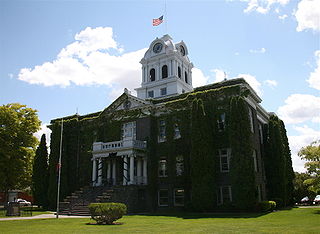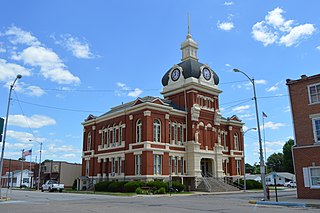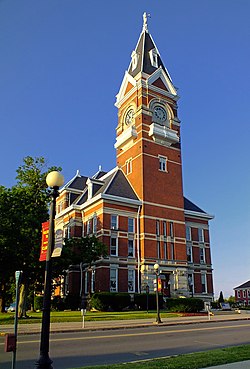
Minneapolis City Hall and Hennepin County Courthouse, designed by Long and Kees in 1888, is the main building used by the city government of Minneapolis, as well as by Hennepin County, in the U.S. state of Minnesota. The structure has served as mainly local government offices since it was built, and today the building is 60 percent occupied by the city and 40 percent occupied by the County. The building is jointly owned by the city and county and managed by the Municipal Building Commission. The Commission consists of the chair of the County Board, the mayor of the City of Minneapolis, a member of the County Board and a member of the Minneapolis City Council. The County Board chair serves as the president of the Commission and the mayor serves as the vice president. The building bears a striking resemblance to the city hall buildings in Cincinnati and Toronto. The City Hall and Courthouse was added to the National Register of Historic Places in 1974.

The Allegheny County Courthouse in downtown Pittsburgh, Pennsylvania, is part of a complex designed by H. H. Richardson. The buildings are considered among the finest examples of the Romanesque Revival style for which Richardson is well known.

The Washington County Courthouse in Hillsboro, Oregon is the courthouse for Washington County, Oregon, in the United States. Washington County was established in 1843 and the first government building was finished in 1852. The current courthouse was built in 1928 with an addition and renovations to the structure in 1972. Currently the building houses courtrooms, the county sheriff's dispatch, staff offices, and the office of the district attorney. The county jail was previously attached to the courthouse.

The Carroll County Courthouse is located in Carrollton, Ohio, and is the second for the county. It was designed by architect Frank Weary in the Second Empire style. The courthouse was placed on the National Register of Historic Places on 1974-10-22.

The Old Indiana County Courthouse is a former courthouse located in Indiana, Indiana County, Pennsylvania. The courthouse was built between 1869 and 1870 and designed by local architect James W. Drum. It was the second courthouse to serve the county, with the first demolished in 1868. The final cost of the project was $150,000. A dedication ceremony took place on December 19, 1870. Former Governor of Pennsylvania William F. Johnston spoke at the ceremony.

The Hancock County Courthouse is a historic courthouse in Findlay, Ohio, United States. Built between 1886 and 1888, it was listed on the National Register of Historic Places in 1973.

The Sullivan County Courthouse is a historic courthouse building in downtown Laporte, Pennsylvania, United States. Built in 1894, this Romanesque Revival courthouse is a rectangular building measuring approximately 92 feet by 60 feet, built of brick with a slate roof. Since its construction, it has been the most prominent building in Sullivan County.

The Dickinson County Courthouse and Jail is an historic complex of governmental buildings located at 700 South Stephenson Avenue in Iron Mountain, Michigan. On May 15, 1980, the complex was added to the National Register of Historic Places.

The Audubon County Court House is located in the county seat of Audubon, Iowa, United States. It was listed on the National Register of Historic Places in 2003 as a part of the PWA-Era County Courthouses of IA Multiple Properties Submission. The courthouse is the third building the county has used for court functions and county administration.

The Wapello County Courthouse in Ottumwa, Iowa, United States, was built in 1894. It was listed on the National Register of Historic Places in 1981 as a part of the County Courthouses in Iowa Thematic Resource. The courthouse is the fourth building the county has used for court functions and county administration. It is part of the Central Park area, which includes: Ottumwa Public Library, Ottumwa City Hall, and St. Mary of the Visitation Catholic Church.

The Osceola County Courthouse in Sibley, Iowa, United States, was built in 1902. It was listed on the National Register of Historic Places in 1981 as a part of the County Courthouses in Iowa Thematic Resource. The courthouse is the second building the county has used for court functions and county administration.

The Dallas County Courthouse in Adel, Iowa, United States was built in 1902. It was individually listed on the National Register of Historic Places in 1973, and is a part of the County Courthouses in Iowa Thematic Resource. In 2009 it was included as a contributing property in the Adel Public Square Historic District. The current structure is the fourth building to house court functions and county administration.

The Delaware County Courthouse, located in Manchester, Iowa, United States, was built in 1894. It was listed on the National Register of Historic Places in 1981 as a part of the County Courthouses in Iowa Thematic Resource. The current structure is the fourth building to house court functions and county administration.

Monongalia County Courthouse is a historic courthouse building located in Morgantown, Monongalia County, West Virginia. The courthouse was erected in 1784 with the current structure built in 1891. This Romanesque style building consists of a two-story building with a basement, five-story clock tower and a three-story South tower. The building measures at 99’ by 83’ by 99’ by 76’ with the first story at fifteen feet high and the second story at twenty-two feet high. The distinctive central clock tower has a pyramidal roof, four doomed buttresses, stone molds over the four clocks and tower windows, arcade belfry, and quatrefoil design with the building date. The original northern facade was covered by an addition built in 1925 with another addition built in 1975. Connected to the courthouse is a two-story Italianate style jailhouse built in 1881.

The Holmes County Courthouse is a historic government building in Millersburg, Ohio, United States. Built in the late nineteenth century, it has been designated a historic site because of its architectural importance.

The Perry County Courthouse is a historic government building in the city of New Lexington, Ohio, United States. Built near the end of the nineteenth century after the end of a county seat war, it is the fifth courthouse to serve Perry County, and it has been named a historic site because of its imposing architecture.

The Garfield County Courthouse, at 8th and Main streets in Pomeroy, Washington, was built in 1901. It is of Late Victorian architecture, designed by Charles Burggraf and built by Spokane contractor August Isle. It was identified as "one of several elaborate county courthouses constructed in Washington around the turn of the century" when it was listed on the National Register of Historic Places in 1974.

The Yavapai County Courthouse is located at 120 South Cortez Street in Prescott, Arizona. The current courthouse building was built in 1916. It was designed by architect William N. Bowman (1868–1944) and it was added to the National Register of Historic Places in 1977. It is also known for its statue of Bucky O'Neill, a Rough Rider and former Mayor of Prescott. Arizona Senator Barry Goldwater announced his presidential candidacy in 1964 from the steps of the courthouse.

Crook County Courthouse is a courthouse located in Prineville, Oregon, United States. The present courthouse, built in 1909, replaced an earlier courthouse built in 1889. In November 2021, voters of Crook County, Oregon approved a bond measure to raise up to $35 million to build a new Justice Center on a different site.

The Scott County Courthouse is a government building in Winchester, the county seat of Scott County, Illinois, United States. Completed in 1885, it is the third courthouse in the county's history.

























